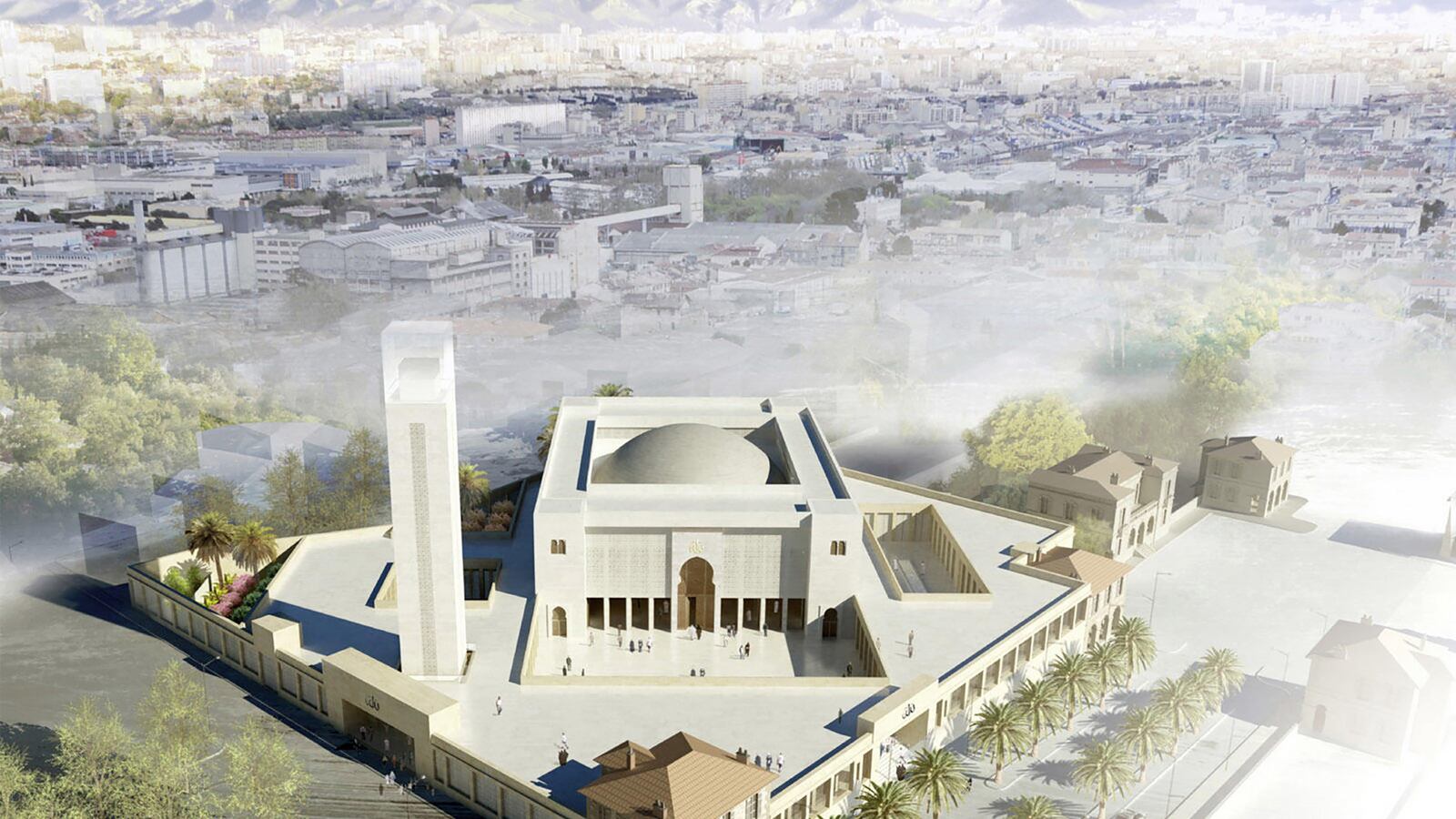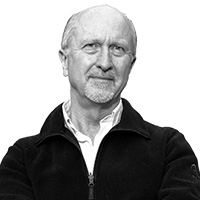Marseille, that great and ancient Mediterranean port of France, is ringed by mountains, and for generations the high ground to the east has been claimed by the Catholic basilica of Notre Dame de la Garde.
There, since 1864, a gilded Madonna has shone like a beacon to mariners on storm-tossed seas, summoning the faithful and affirming the Christian identity of the city beneath.
Except that Marseille, after another generation or two, may well have a Muslim majority, which is why 15 years ago the city government approved a giant mosque on one of the western hilltops as a symbol of approbation and integration.
The cornerstone was laid in 2010. And to this day that is the only part of the building that exists.
The story of how the Grand Mosque of Marseille was conceived and why it’s never been built is not exactly what one might expect.
To be sure, the right-wing National Front tried to block its construction, but those efforts were unsuccessful. The core problem was one of competing interests, identities, and egos within the Muslim community itself.
In late 2010, while working on a piece about Marseille for National Geographic, I questioned the city’s longtime mayor, Jean-Claude Gaudin, about the mosque project. Already by then it was a subject of frustration as much as hope.
Gaudin told me at that point there were 62 little mosques and prayer rooms in Marseille, but he knew that was far too few for 250,000 or more people in the city from Muslim backgrounds. During Friday prayers, in some quarters, worshipers spill onto the streets and block traffic.
These informal little mosques also are ripe for takeovers by militant Salafists preaching a radical form of Islam detached from and hostile to mainstream French (including French Muslim) society.
Such Salafist prayer rooms often have served as incubators for extremists, and since the stunning terror attacks in Paris last year and in Brussels last month, French police have been cracking down on them throughout the country. An oft-repeated cliché is that Marseille could become “the Molenbeek of France”—an allusion to the Brussels neighborhood that served as a staging area for the atrocities of November and March.
Certainly there are what amount to “no-go” areas in the northern districts of the city, like the infamous Castellane public housing estate periodically and unsuccessfully besieged by police.
The character of the Kalashnikov-toting thugs there is criminal, not religious, but if there is anything security and intelligence services have learned in recent years, it’s that there can be an enormous, deadly overlap.
Authorities now believe there are about 95 mosques and prayer rooms of various guises in Marseilles, many of them unregistered, some of them clandestine—and some of them unable to get official standing no matter how hard they try.
La Provence, the leading local paper, recently profiled two men who have been trying for 15 years to turn a derelict boxing gym into a recognized religious establishment only to be told repeatedly they had failed to comply with one ordinance or another. And this in a neighborhood, Oliviers A, that is dying around them, “with young people dealing, balconies crumbling, businesses closing,” as La Provence put it. “Food stores, news stands, pharmacies, at Oliviers A they’ve all pulled down their shutters.”
The men who run the mosque, Kader Azia and Kader Sarhaoui, know how vulnerable to radicalization their neighborhood is, and appear to be philosophical about the interest the cops take in their mosque.
La Provence quoted both men as saying, “Yes, we are under surveillance and we know it…With what’s happened, it’s to be expected that the state would be interested in mosques. But we have nothing to hide.”
How the Grand Mosque of Marseille might have changed the city and the lives of Muslims in it is impossible to say because, as La Provence put it, at this point “the Grand Mosque is nothing more than a mirage.”
When I talked to Mayor Gaudin about it back in 2010, he already seemed wistful. “The population approved it—by 60 percent they understood that each religion ought to have a significant monument,” he said.
In 2006 the municipality gave unanimous approval to the building permit. The director of the main mosque in Paris came for the laying of the cornerstone in May 2010. A leading Socialist Party politician proclaimed it would signify the “fraternal cohabitation of the communities.”
But from the beginning there also were critical misunderstandings.
The site the city made available was the sprawling old municipal slaughterhouse and its grounds. Gaudin thought one of the cavernous buildings there could be restored and converted into a Muslim place of worship.
But the fact that oceans of blood had flowed there from animals not killed in halal (religiously acceptable) ways made that idea seem grotesque to many observant Muslims.
No, the old buildings would have to be torn down and new ones built that would be oriented appropriately toward Mecca and thoroughly cleansed of the gore from before. Designs were drawn up for a modern structure with a towering minaret where the faithful could be called to prayer.
But then the non-Muslim community started to push back, unwilling to accept the idea they’d be awakened, like it or not, before dawn. “Prayer is better than sleep,” the muezzin intones. Not everyone agrees.
So, the committee that had formed to build the mosque conceded the point and decided there would be no audible call to prayer. Instead, a powerful light would shine from the minaret, visible (like the gold Madonna of Notre Dame de la Garde) all over the city.
But the idea that a minaret might challenge the steeple of Notre Dame for dominance, or even as a counterpoint on the Marseille skyline, was anathema to many conservatives.
Predictably, the far-right National Front tried to stop the project. Its local representatives warned that French culture was being “submerged” beneath waves of immigrants, and its attorneys took the project to the courts, complaining that the nominal rent paid the city for the property was too low, then that there was not enough parking space.
The project weathered those legal and political attacks, too.
But while court battles were won, and the Grand Mosque was publicized, and, of course, a slick website created, the core question—who would pay to build it, and who would decide who ran it, and how—could not be resolved.
Marseille’s Muslim community is divided, sometimes bitterly, among many different ethnicities and historic nationalities. There are, for instance, large numbers of Comorians from the archipelago off the southwest coast of Africa. There are sub-Saharan Africans, Arabs from the Middle East, and large numbers of Moroccans as well as the strong Algerian community.
The competition for control of the Grand Mosque was partly a matter of national honor and influence for potential sponsors and partly a question of local egos.
The first committee was run by Noureddine Cheikh, who was largely identified with Algerian support, but he was ousted in an awkward 2010 election by Abderrahmane Ghoul, thought to be more closely identified with Morocco.
The estimated cost for the completed mosque was about $30 million, which is not astronomical for major municipal projects. But the city of Marseille would not pay (separation of church and state being one obvious reason), and limits were put on who could foot the bill.
It appears nobody wanted the Saudis to fund the mosque. Their Wahhabi imams have been at the vanguard of Salafi and jihadi movements in Europe.
Money from Qatar, the United Arab Emirates, and other Gulf countries might have posed similar problems. A central idea behind the Grand Mosque was to put a relatively open-minded French imam in charge.
Again and again, the question came down to whether Morocco or Algeria would step up to the plate, and there was no question of both contributing since the two countries are bitter enemies, waging a decades-long proxy war against each other in the Western Sahara.
Then came the uprisings across the Arab world in 2011, and monies dried up almost completely. “We had serious promises before the Arab Spring,” Ghoul told the French daily Libération last year. “Now those countries have other concerns.”
Over the last several months, even the most enthusiastic backers of the Grand Mosque project in Marseille’s city hall have given up. “For us, the file is closed,” Salah Bariki, who’d been in charge of it, told Libération last year.
On Friday, I called Stéphane Gireau, the spokesman for Mayor Guerin, to see if anything had changed. “Not a single thing,” he said. “There has been no movement at all.”
Indeed, it is hard to imagine, today, a minaret towering over Marseille. The time when that design for moderation might have become a reality is past. But the people it was meant to call to prayer are still there, and without a Grand Mosque to help guide them, we can only imagine what summons they will hear instead.





